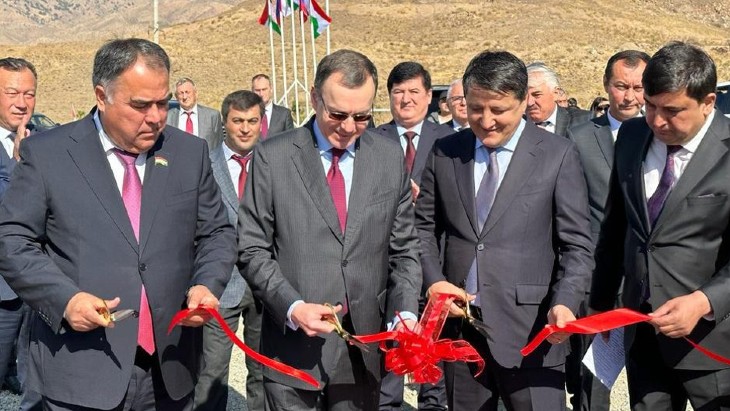The Russian-state nuclear corporation said that it has reduced the height of the uranium sand dump from 65 metres to 35 metres and covered it with a 1.5 metre layer of clean soil, and reported that the background radiation on the perimeter of the reclaimed facilities was at normal levels.
It said that three kilometres of road, and power lines, were worked on as part of infrastructure measures to facilitate the work, while at the reclaimed sites, the remains of buildings were dismantled, the protective soil layer added as well as a drainage system. In total, more than 1.2 million cubic metres of soil were moved. A ceremony to mark the end of the work (see picture above) was attended by Sherali Kabir, Tajikistan Minister of Industry and New Technologies, Nikolay Spassky, Deputy Director General of Rosatom and Rajabboy Akhmadzoda, the head of Sughd region of Tajikistan.
The contract for the environmental remediation of the former uranium mining and processing site was signed last September. The agreement was concluded as part of the fulfilment of international obligations in accordance with the international target programme of the CIS countries for the rehabilitation of areas affected by uranium mining industries. The project is financed by the countries participating in the international target programme - Russia, Kazakhstan, Tajikistan and Kyrgyzstan.
Central Asia served as an important source of uranium for the former Soviet Union. Uranium was mined for more than 50 years and uranium ore was also imported from other countries for processing, and large amounts of radioactively contaminated material were placed in mining waste dumps and tailing sites. Most of the mines were closed by 1995 but very little remediation was done before or after the closure of the mining and milling operations.
The Taboshar deposit was one of the largest in the former USSR, where active uranium mining was carried out from 1945 to 1965 before being closed in the 1970s.
Kabir said it was the country's first project within the programme for reclamation of territories of states affected by uranium mining production. He said: "All environmental features of the area were taken into account, including the flora and fauna of the area, and the design documentation passed all the necessary state examinations. Russian colleagues approached the implementation of the project with great responsibility in accordance with international standards and norms. In turn, companies and specialists from Tajikistan participating in the project not only contributed to its implementation, but also gained a lot of experience."
Spassky, from Rosatom, which is parent of TVEL, whose Central Design and Technological Institute was the contractor, said: "Innovative methods have been developed to bring uranium heritage sites into a safe state. We have accumulated extremely useful experience in carrying out such work. The living conditions of people across vast territories have been improved, and the preconditions have been created for the growth of the well-being and economy of the region."
Speaking at the ceremony to mark the completion of the work, he also looked ahead to future cooperation beyond reclamation issues, saying Rosatom "has competencies in the field of nuclear medicine, geological exploration and mining of uranium, rare and rare earth metals, scientific research and personnel training. We are now discussing specific joint projects in these areas with our Tajik partners".
According to the Tass news agency, he also told reporters that "if in the future, based on the enormous potential that has been created, based on the human relations that we have established with our Tajik colleagues, if the Tajik side shows interest in nuclear energy, in the construction of a nuclear power plant of large or small capacity of Russian design in Tajikistan ... we will be happy".





_23621.jpg)

_63865.jpg)
_18570.jpg)





